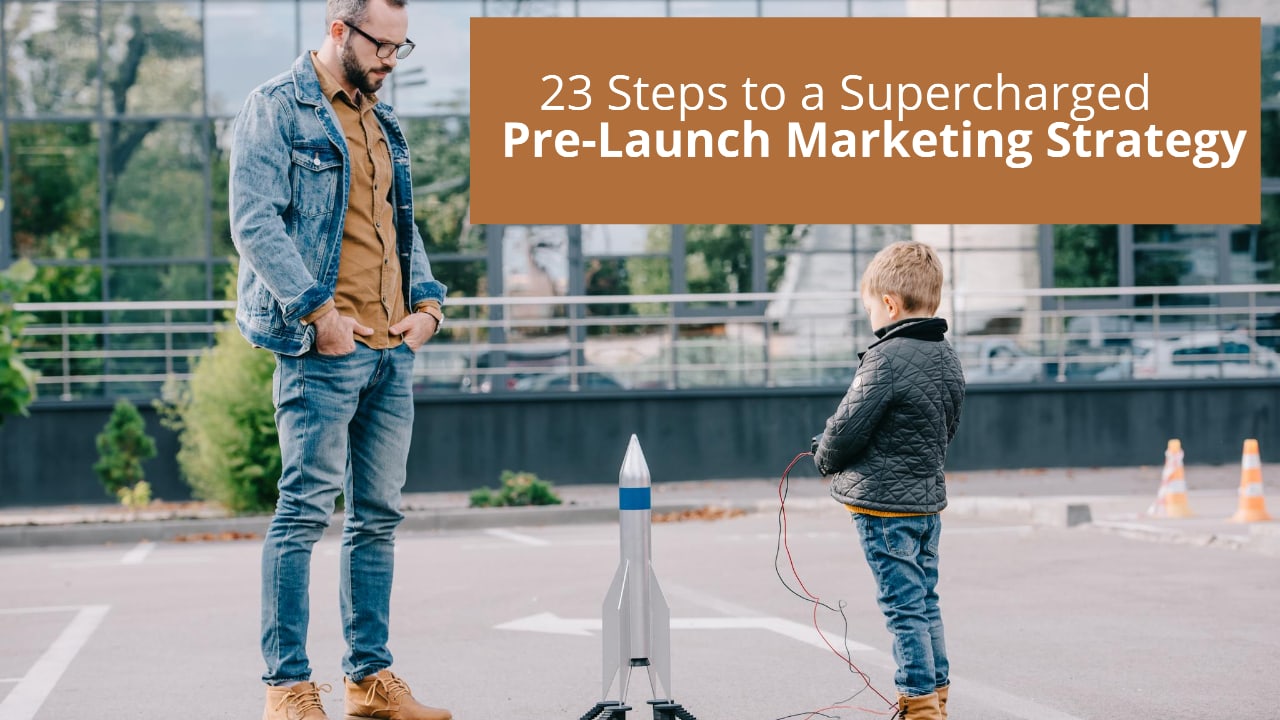It’s exciting to launch a new product and watch it skyrocket in popularity. But a whole lot of work goes into building a pre-launch marketing strategy that makes the launch successful.
The goal of a pre-launch marketing strategy is to build support for the product, garner attention in the marketplace, generate positive feedback, and set the stage for an effective launch.
The tactics you implement during the pre-launch phase will significantly impact your launch sales.
Here are 23 tips to help you develop an effective pre-launch marketing strategy and make your product launch a success.
Table of Contents
Back Office
1. Research Your Users and Competitors
Research your target buyers by identifying their needs and use-cases.
Then use it to determine your unique selling point (USP). A unique selling point is a very brief explanation of what makes your brand special and different from other brands and products. It is a quick and easy way to stand out in the crowd.
Note that a cheaper price is not a USP. Many first-time entrepreneurs think that offering their product for a lesser price will work, but it rarely does.
A quick strategy you can use is to take a careful look at your competitors and see where they fall short. Can you use it to make your product better?
2. Find Your Message
For a brand to succeed, it has to have a strong message.
But most people confuse a message with a tagline or slogan. Your message is not just a tagline or a slogan. It’s the reason you do what you do. It’s the core of your brand, the essence of what you’re about.
For instance, Apple’s message is based on empathy. It says, “We will truly understand their [our customers’] needs better than any other company”.
Finding your message is the first step to building your brand, and once you have it, you can turn it into a marketing strategy.
You can start right away by asking these two simple questions: 1. What values do you stand by or represent to your customers? 2. What are you going to do that your competitors aren’t? Finding your message will become easy once you’ve answered to these two questions.
3. Listen to Your Market
In the age of social media, it’s easier than ever to listen to your customers, their needs, and use cases.
But the problem is most businesses spend more time in making the product than they do determining how people will use it.
Customers come in many shapes and sizes, but they’re all just looking for a company that understands them and meets their needs. If you’re actively listening to your customers, you’ll be able to adapt your product to their ever-changing needs. Once your customers see that their input is valued, they’ll feel appreciated and help you spread the word out.

Generate Buzz
1. Connect with Influencers in Your Industry and Do Influencer Marketing
If you are trying to reach out to a niche market, then influencers will be your best bet.
Today, many companies have started engaging influencers in their marketing campaigns. This is because influencers have a lot of influence over the decisions of their followers. They can help you spread the word out fast and effectively.
Let’s consider an example: if you’re opening a new restaurant, you might want to have some New York Times food critic review your restaurant on the opening day.
2. Draw Suspense
“Show it off, but you don’t tell them what it is/what it has”.
Ever since the dawn of time, man has been trying to draw suspense and mystery to attract attention and generate buzz. Marketers have also taken note of this.
Building suspense is a powerful tool. It keeps your audience wanting for more. Your marketing strategy should be planned in advance and should include a timeline with milestones leading up to your launch day.
Words and phrases like ‘something amazing is coming‘ or ‘you won’t believe what we are about to bring you‘ can create lots of buzz and leave people speculating on what’s coming.
3. Leak Some Things
A large majority of the marketing campaigns today are built on leaks and rumors. They feel like they were unintentional, but they rarely are.
To build interest in your product, you need to attract the attention of your target audience by strategically leaking out some information to the masses. This promotes speculation and word-of-mouth publicity. It is effective because it ensures that the company gets to the top of the mind share of its target audience. Once you reach there, it’s only an upward ride then.
4. Call for Early Adopters
I’ve been in the technology industry for four years now, but I never heard about the concept of early adopters until recently in 2020, when I was involved with the marketing team of a SaaS product. It blew my mind.
Early adopters are trendsetters who lead the market. When they use a new product or service, they help others feel comfortable trying it too.
They have a passion for technology, and they’re always looking for new products to get their hands on. If you can get early adopters to use and support your product, this could help you exponentially when the product launches.
Further, early adopters also help you test your product, identify use cases, and build an early customer base.
5. Create a Promo Video
Video is a powerful marketing tool for quite some time now. If you can create a video that tells the story about your product idea and make it go viral, you can create immense interest in your product. Particularly, on sites like YouTube, videos do wonders in building momentum for a brand before the launch.
Promo videos are inexpensive, easy to make, and easy to share. They can be really helpful when you want to get your message across in an entertaining and concise manner.
6. Run a Crowdfunding Campaign
The main advantage of a crowdfunding campaign is that it helps you to reach out to an audience who is genuinely interested in the product.
Most crowdfunding platforms are designed to help you reach your target buyers without the need for a high marketing budget.
Plus, most of those buyers are eager to try out your product. This is because they get a chance to sample the product way before the actual launch. Moreover, you get additional feedback that can be used to make your product better.
Ideally, you would want to run the crowdfunding campaign several months before the actual release.
7. Do Some Free Giveaways + Have a Public Leaderboard
Giving away free stuff is an evergreen marketing strategy and a great way to get your product talked about.
The benefits of doing a giveaway are two folds: first, it creates buzz, and second, it helps you build a targeted email list.
To make it more effective, give away something that is brag-worthy. People will be excited to share it with their friends and colleagues which will get you more eyeballs.
We recommend you also create a leaderboard where users can track their positions, share their results, and boast about them.

Work On Your Organic Visibility
1. Plan out Your Content Calendar
A content calendar is used to determine what content will be created, how often it will be posted, and how it will be spread across various platforms. It gives you a high-level view of your content marketing efforts, and see if there are any gaps in your strategy. You can then fill these gaps with unique, quality content that makes your audience keep coming for more.
2. Write Guest Posts
Organic traffic (in most cases) is low in the pre-launch period because most people don’t yet know about your product.
Guest blogging could be a great way to expose your brand to an entirely new audience and bring organic traffic. Write guest posts on high-traffic sites and link them back to your website.
Remember, it’s always better to start guest blogging as early as possible. But most people and businesses start guest blogging when it’s too late or the product is already live.
You need to understand that you are doing guest blogging for the initial traffic. Sending traffic to a website that’s already popular isn’t going to help you much. In that case, it’s better to focus on your own website content, SEO, and ranking.
3. Get Active on Social Media
Pre-launch period is the perfect time to get active on social media. You still have an opportunity to change and update things before the launch.
If you do it right, social media is one of the best ways to increase your exposure, garner valuable feedback, and bring your product in-front of a huge audience.
Your first step should be to target a niche audience. Building a following of people interested in your product or service will help you increase circulation when word about it goes viral.
Second, you can also benefit from shout-outs from reputable blogs and larger influencers.
That being said, you need to create informative and engaging content that either entertains or educates your target audience. Other content ideas include:
a. Giving public updates about your product development and anything that helps you garner attention.
b. Sharing behind-the-scenes photos/videos of your team and work culture.
4. Create Shareable Content
The best content marketers have learned that creating top-of-funnel content like blog posts, ebooks, whitepapers, and other original content is great, but creating sharable content like videos and infographics is even better.
Videos and infographics don’t just have a sharability advantage, there’s more. Videos are popular because they’re visual and make your message more memorable, while infographics simplify complex information into something that’s easier for people to digest. In fact, they both have been shown to increase engagement and performance for blog posts too.
So add some videos and infographics to your content creation process and encourage sharing.
5. Leverage Storytelling
The same way a movie can make an audience care about the outcome of the story and get them rooting for the hero, your product’s story can help you connect with potential buyers and get them rooting for your product.
Stories have the power to connect people, build your brand, and make your content more shareable. The key is to make your product’s story as human as possible. No one really wants an impersonal, slick, sterile presentation of your product.
For example, in early July 2019, a video of an Ethiopian farmer using a smartphone to harvest crops went viral on Facebook. In under a month, the video had over 4 million likes.
Also read: 10 Ways Businesses Are Using Storytelling to Level Up their Marketing.

Generate Leads
1. Build a Coming Soon Page
Coming Soon pages are a great way to build pre-launch hype for your product.
With the help of coming soon pages, you can use your social media channels to spread the word about your upcoming launch. These can also be a great way to get users to subscribe to your newsletter and get those early-bird customers.
Once you have an email list, you can keep them informed on the progress of your product through newsletters. So that when your product launches, you’ve customers eagerly waiting for it.
2. Build a Landing Page
A landing page is a single-page website used to drive targeted traffic to your lead generation form.
These landing pages are usually simple and to the point, containing only the information that a visitor needs to convert.
This can include information like product specifications, the benefits, and how your product solves your customer’s problems. Get a copywriter to help you with this.
You can also add a FAQ section to overcome objections and answer the most frequent questions your buyers have.
Additionally, you can add a countdown timer to make things more effective.
3. Re-market
Re-marketing is a powerful tool in your marketing arsenal because it allows you to re-engage with your prospects, who were interested in your product/service, but didn’t initially convert (gave you their email in this case).
Re-marketing is also an intelligent way to counteract a wave of negative publicity about your product (if you need to do it).
More than 50% of people who visit your website will not convert initially. By re-marketing, you bring those visitors back to your landing page, which practically increases conversion.
4. Take Preorders
Most people confuse crowdfunding with taking preorders, but they are not the same.
Taking preorders doesn’t involve offering rewards for donations. It’s simply a way for someone to secure their order of a product that is yet to be produced.
If you can build considerable buzz around your product and offer some discounts to people who preorder, there will be lots of people eager to join the bandwagon. In fact, this could further help you with more marketing and publicity.

Build Interest
1. Mention Your Upcoming Product to Your Subscribers and Start Segmenting Your List for Interested Contacts.
As you move towards the launch, you need to start segmenting your list to find the people who are interested in what you’re offering.
Start by adding a CTA to know more about your product, along with the link to your landing page in the footer of your email, and ask your list to opt-in for more updates.
Then, create a separate mailing list and send them automated emails that build interest and presell them on your product.
If you can do this right, you will have lots of buyers ready on your lunch day.
2. Create a Website
Although we have built a landing page for our product launch, as the launch day comes near, you also need to have a website.
Having an attractive and informative website that clearly defines your product and how it solves your target customers’ problems can help a lot.
Plus, websites are made to encourage exploration. You can add a lot of info like your team, core values, detailed product specifications, a contact us section, and a blog.
All this will help you build trust and credibility with your prospective customers.
3. Host a Launch Event
Planning a big launch event for your product or service is the perfect way to drum up excitement, buzz, and media coverage.
Most people ask me if it is worth the time and effort, and in most cases, yes, it is. When done right, launch events are a great way to get the word out about your new product.
And if you have the event planned well in advance, it could also help you gauge the interest, make approximations of interested people, and measure how well has your pre-launch marketing strategy performed so far, and if you need to tweak the strategy.
If you have done everything well, you would see lots of people interested in attending the event.

Nurture
1. Send Automated Drip Emails
There’s no doubt that email marketing is the most effective way to nurture leads.
It helps build relationships with customers, overcome objections, and increase conversions.
In fact, most businesses start using lead nurturing way before they launch their product. So that by the time they launch, they have thousands of red-hot leads who are at the bottom of the funnel.
To make if more effective, use high performing copy to engage, educate, and persuade your prospective customers. If you need, take help from a copywriter.
Conclusion
A pre-launch marketing strategy can help you get your product off on the right start, but it’s something many new businesses overlook.
A carefully crafted pre-launch marketing strategy is one of the most critical parts of the product launch – it’s where you lay the foundations for the future success of your product, and it’s absolutely crucial to its success.
The goal is to generate hype, get more eyeballs, and position your product as a solution to your ideal customers. So that when the product actually launches, your prospective customers are ready to buy.








